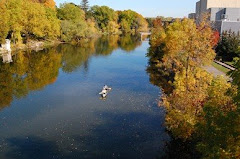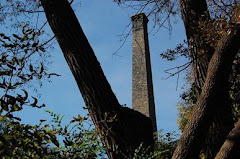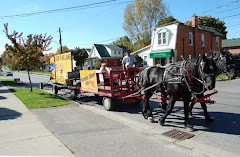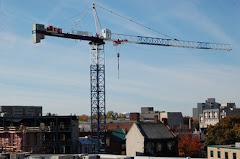So I was minding my own business (sleeping) at 6:30 this morning and I get a phone call from one of the leaders of a group of protesters intending to stop work on the Hanlon Creek Business Park site. If you've been reading this blog, you know the story. Anyway, being only half awake when they called, they were smart enough to follow
Press Release: Save Our Old Growth Forest!
On July 27th, 2009, at approximately 7 am, over 50 people gathered at the site of the proposed Hanlon Creek Business Park (HCBP) to protest the environmental destruction inflicted by Drexler Construction, as approved by the City of Guelph.
To date, Drexler has begun the process of building a 4-lane wide culvert over Tributary A of the Hanlon Creek, which is the first construction project for the HCBP. This has involved:
• The bulldozing of a 4-lane road,
• construction of silt fences surrounding Tributary A,
• the cutting of trees and destruction of wildlife habitat along Tributary A.
Drexler is also contracted to dig up the gas lines that run parallel to Downey Rd., dam and divert Tributary A, and build a culvert crossing to facilitate the construction of the 74-acre road network in preparation for Phase 1 of the Hanlon Creek Business Park.
There has been mounting opposition to the HCBP since its instigation in 1993, which has greatly accelerated in the past 8 months. Numerous organizations have concerns regarding the proposed development, including its effects on both the human and non-human inhabitants of the site and surroundings.
The land that is currently being destroyed has not always been the property of the City of Guelph. Before it was purchased from the township of Puslinch, this land was hunting and gathering grounds for the Neutral Nation and other Indigenous nations for over 11,000 years.
This exceptionally environmentally-sensitive area is also home to the Paris-Galt moraine, which has been identified by Mayor Karen Farbridge and MPP Liz Sandals as extremely important for the recharge and filtration of Guelph’s drinking water. Tributary A, a stream that feeds into the Hanlon Creek, which in turn feeds into the Speed and Grand Rivers, is being devastated by the construction of the culvert. These waterways provide drinking water for several communities downstream of Guelph, including Brantford, Six Nations, and Cambridge. The impact of this development is not confined to Guelph, and any development of the site risks the contamination of these communities’ drinking water. The Grand River is already on the verge of collapse due to a combination of human impacts, and as stewards of these rivers we need to protect them from any further possible risk.
We believe that the continuation of this development is unlawful, as it is failing to abide by the laws of the Provincial Policy Statement, the Federal Species at Risk Act, and the Provincial Endangered Species Act. We believe the City of Guelph has deceived the public and evaded adequate wildlife protection measures by declaring that the construction of the HCBP will have no negative impact on the Provincially Significant Wetland and the habitats of two threatened species on the site, the Jefferson Salamander and Western Chorus Frog. The 15-30m buffer of adjacent lands are extremely inadequate and defy scientific studies that state that a range of 120-500m adjacent lands are needed. Further, section 2.1 of the Provincial Policy Statement mandates protection of lands within 120m adjacent to the Provincially Significant Wetland, which includes the site of the culvert.
Continued development of the HCBP is causing great harm to the plant and animal inhabitants of the land. This site is a rich and thriving ecosystem. It is home to over 112 species of birds, 16 species of mammals, 270 species of plants and trees, and 20 species of reptiles and amphibians. Of the species identified, both the Western Chorus Frog and the Jefferson Salamander are Federally protected, with the Jefferson Salamander also being Provincially protected. Though the City’s own environmental consultants confirmed the presence of the Jefferson Salamander, the fact that the destruction of this area has proceeded is a testament that the City’s concerns lie not with the adequate protection of the Jefferson Salamander or the environment in general, but with the continuation of an expensive, unlawful, and ill-thought-out development. When Mayor Karen Farbridge says that the finding of the Jefferson Salamander proves “The City remains committed to protecting the habitat of endangered species,” it is obviously a lie if the City proceeds with any development of the site.
There is also the question of why this land is being developed. With the current economic situation, it is financially irresponsible for the City of Guelph to dedicate tens of millions of dollars, nearly it’s entire capital budget, to the creation of an industrial development that has no proposed buyers and very little future. Countless industrial lots within city limits have sat vacant for years, The city has no guarantee that the public funds allotted to the HCBP will ever be recuperated.
For the above reasons, we have taken it upon ourselves to prevent the destruction of this vital land. Our demands to the City of Guelph are:
• To listen to public outcry and respect the intrinsic importance of this land by immediately ending this development and terminating their contract with Drexler.
• To compensate the skilled labourers of Drexler Construction for lost wages, including those who choose to stand with us.
• To publicly apologize to the people of Guelph for disregarding their opposition to this development..
Concurrent to this action, others who feel similarly will be gathering at City Hall at 6 pm on Monday, July 27th. Please come and voice your opposition to the Hanlon Creek Business Park to the mayor and city councillors, who will be entering City Hall for the council meeting at 7 pm.
Please note: though we recognize the work of LIMITS, we are in no way affiliated with or organized through them.
My next stop is to go down there and see what's what. I'll update when I have more.
Press Release: Save Our Old Growth Forest!
On July 27th, 2009, at approximately 7 am, over 50 people gathered at the site of the proposed Hanlon Creek Business Park (HCBP) to protest the environmental destruction inflicted by Drexler Construction, as approved by the City of Guelph.
To date, Drexler has begun the process of building a 4-lane wide culvert over Tributary A of the Hanlon Creek, which is the first construction project for the HCBP. This has involved:
• The bulldozing of a 4-lane road,
• construction of silt fences surrounding Tributary A,
• the cutting of trees and destruction of wildlife habitat along Tributary A.
Drexler is also contracted to dig up the gas lines that run parallel to Downey Rd., dam and divert Tributary A, and build a culvert crossing to facilitate the construction of the 74-acre road network in preparation for Phase 1 of the Hanlon Creek Business Park.
There has been mounting opposition to the HCBP since its instigation in 1993, which has greatly accelerated in the past 8 months. Numerous organizations have concerns regarding the proposed development, including its effects on both the human and non-human inhabitants of the site and surroundings.
The land that is currently being destroyed has not always been the property of the City of Guelph. Before it was purchased from the township of Puslinch, this land was hunting and gathering grounds for the Neutral Nation and other Indigenous nations for over 11,000 years.
This exceptionally environmentally-sensitive area is also home to the Paris-Galt moraine, which has been identified by Mayor Karen Farbridge and MPP Liz Sandals as extremely important for the recharge and filtration of Guelph’s drinking water. Tributary A, a stream that feeds into the Hanlon Creek, which in turn feeds into the Speed and Grand Rivers, is being devastated by the construction of the culvert. These waterways provide drinking water for several communities downstream of Guelph, including Brantford, Six Nations, and Cambridge. The impact of this development is not confined to Guelph, and any development of the site risks the contamination of these communities’ drinking water. The Grand River is already on the verge of collapse due to a combination of human impacts, and as stewards of these rivers we need to protect them from any further possible risk.
We believe that the continuation of this development is unlawful, as it is failing to abide by the laws of the Provincial Policy Statement, the Federal Species at Risk Act, and the Provincial Endangered Species Act. We believe the City of Guelph has deceived the public and evaded adequate wildlife protection measures by declaring that the construction of the HCBP will have no negative impact on the Provincially Significant Wetland and the habitats of two threatened species on the site, the Jefferson Salamander and Western Chorus Frog. The 15-30m buffer of adjacent lands are extremely inadequate and defy scientific studies that state that a range of 120-500m adjacent lands are needed. Further, section 2.1 of the Provincial Policy Statement mandates protection of lands within 120m adjacent to the Provincially Significant Wetland, which includes the site of the culvert.
Continued development of the HCBP is causing great harm to the plant and animal inhabitants of the land. This site is a rich and thriving ecosystem. It is home to over 112 species of birds, 16 species of mammals, 270 species of plants and trees, and 20 species of reptiles and amphibians. Of the species identified, both the Western Chorus Frog and the Jefferson Salamander are Federally protected, with the Jefferson Salamander also being Provincially protected. Though the City’s own environmental consultants confirmed the presence of the Jefferson Salamander, the fact that the destruction of this area has proceeded is a testament that the City’s concerns lie not with the adequate protection of the Jefferson Salamander or the environment in general, but with the continuation of an expensive, unlawful, and ill-thought-out development. When Mayor Karen Farbridge says that the finding of the Jefferson Salamander proves “The City remains committed to protecting the habitat of endangered species,” it is obviously a lie if the City proceeds with any development of the site.
There is also the question of why this land is being developed. With the current economic situation, it is financially irresponsible for the City of Guelph to dedicate tens of millions of dollars, nearly it’s entire capital budget, to the creation of an industrial development that has no proposed buyers and very little future. Countless industrial lots within city limits have sat vacant for years, The city has no guarantee that the public funds allotted to the HCBP will ever be recuperated.
For the above reasons, we have taken it upon ourselves to prevent the destruction of this vital land. Our demands to the City of Guelph are:
• To listen to public outcry and respect the intrinsic importance of this land by immediately ending this development and terminating their contract with Drexler.
• To compensate the skilled labourers of Drexler Construction for lost wages, including those who choose to stand with us.
• To publicly apologize to the people of Guelph for disregarding their opposition to this development..
Concurrent to this action, others who feel similarly will be gathering at City Hall at 6 pm on Monday, July 27th. Please come and voice your opposition to the Hanlon Creek Business Park to the mayor and city councillors, who will be entering City Hall for the council meeting at 7 pm.
Please note: though we recognize the work of LIMITS, we are in no way affiliated with or organized through them.
My next stop is to go down there and see what's what. I'll update when I have more.

















No comments:
Post a Comment